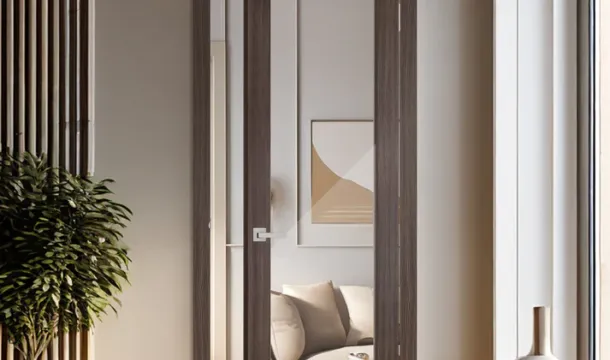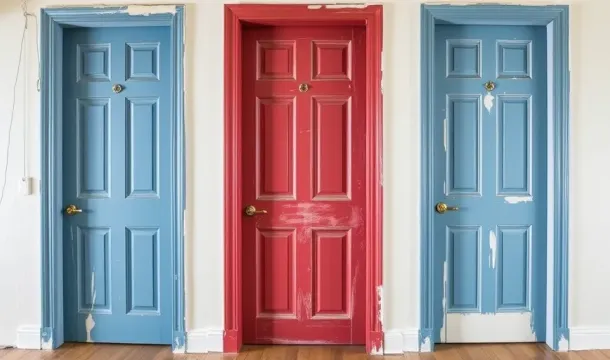Climate Zones Impact on Choosing Doors in Canada
Popular Articles
- Choosing the Perfect Interior Doors for Your Canadian Home
- A Complete Guide to Choosing Interior Doors for Canadian Homes
- The Challenges of Painting Interior Doors
- Understanding Interior Doors and Their Role in Your Home
- The Perfect Blend of Reliability and Design: Interior Doors with Italian "Sandwich" Technology
Prioritize doors with high insulation ratings when dealing with colder territories, especially in northern and mountainous areas where temperatures frequently plunge below -20C. Materials like fiberglass or insulated steel with polyurethane cores provide superior thermal resistance, reducing heat loss and lowering energy bills.
In milder southern regions, solid wood doors with proper weatherstripping offer a balance between aesthetics and moderate insulation needs. However, ensure these are treated against humidity fluctuations to prevent warping during humid summers and freezing winters.
Areas prone to heavy snowfall or rain require doors equipped with durable seals and moisture barriers to maintain indoor comfort and prevent drafts. Installing adjustable thresholds can further enhance protection against water infiltration while preserving airtightness.
For urban dwellers facing significant temperature swings between day and night, multi-layered door constructions featuring thermal breaks help minimize condensation buildup on interior surfaces. This reduces the risk of mold growth and maintains structural integrity over time.
Understanding the specific environmental demands of your location enables targeted selection of door styles and materials that optimize insulation performance without compromising design preferences or budget constraints.
Selecting Doors for Cold Climates
Prioritize doors with high R-values to maximize thermal resistance and reduce heat loss. Fiberglass and steel doors filled with polyurethane foam provide superior insulation compared to solid wood options, which tend to have lower insulating properties.
Look for products featuring a multi-layer core design. A door with a thermal breakan insulating barrier between the exterior and interior surfacesprevents cold bridging, significantly improving energy retention during harsh winters.
Key Features to Consider
- Weatherstripping: Choose doors equipped with durable, airtight seals around all edges to block drafts and moisture infiltration.
- Double or Triple Glazing: If the door includes glass panels, ensure they are double or triple glazed with low-emissivity (Low-E) coatings to minimize heat transfer while maintaining natural light.
- Material Stability: Opt for materials resistant to warping or cracking under freezing temperatures. Fiberglass and steel maintain structural integrity better than untreated wood in sub-zero conditions.
Installation Tips for Enhanced Performance
- Seal gaps using expanding foam insulation around the frame to eliminate air leaks that compromise warmth.
- Install insulated thresholds designed to prevent cold air intrusion at the bottom of the door.
- Ensure tight alignment and proper hardware adjustment; even minor misalignments can cause significant heat loss in frigid environments.
A well-insulated entryway door reduces heating costs substantially while maintaining indoor comfort during extended periods of severe cold. Prioritizing insulation technology and material durability will yield long-term energy savings and improved home resilience against winter elements.
Door Materials for Humid Regions
Fiberglass and vinyl doors excel in high-moisture environments due to their resistance to warping, swelling, and rot. Unlike wood, these materials maintain structural integrity without absorbing water, making them ideal for bathrooms, basements, or coastal areas.
Steel doors with a rust-resistant coating offer durability and enhanced insulation properties. Their solid cores prevent moisture infiltration while providing excellent thermal barrier performance, reducing energy loss in humid conditions.
Engineered wood products, such as medium-density fiberboard (MDF) with waterproof veneers, combine the aesthetic appeal of natural wood and improved resistance against mold and mildew. These should be paired with high-quality sealants to extend lifespan in damp spaces.
The insulation value of doors in moist settings is critical to avoid condensation buildup that can lead to material degradation. Look for models featuring foam cores or insulated chambers that stabilize internal temperatures and minimize humidity-related damage.
Avoid untreated solid wood doors unless they undergo specialized treatments against moisture penetration. Regular maintenance with sealants or paints designed for wet environments will also enhance durability but may not match the longevity of synthetic alternatives.
Ultimately, selecting materials engineered for moisture resilience combined with superior insulation ensures functional performance and preserves appearance over time in humid interiors.
Weatherproofing Doors in Coastal Areas
Utilize fiberglass or marine-grade aluminum doors with a high-performance weather-resistant finish to withstand salty air and frequent storms. These materials resist corrosion and warping far better than traditional wood. Prioritize models with integrated insulation coressuch as polyurethane foamto maintain interior comfort despite fluctuating temperatures and humidity.
Seal all door edges meticulously using silicone-based weatherstripping, which retains flexibility longer under moist conditions compared to standard rubber gaskets. Install adjustable thresholds that prevent water infiltration during heavy rain and storm surges while allowing for smooth operation.
Protective Coatings and Maintenance
Apply UV-resistant coatings to minimize sun damage and fading caused by reflective ocean light. Reapply sealants annually to ensure continued protection against moisture penetration. Regularly inspect door hardware for rust; opt for stainless steel or coated fasteners specifically designed for marine environments.
Design Features Enhancing Durability
Incorporate storm doors with impact-resistant glass to add an extra layer of defense against wind-driven debris and salt spray. Choose door designs featuring raised thresholds and sloped sills that facilitate rapid drainage. Proper ventilation around frames helps reduce trapped moisture, preventing mold growth without compromising insulation efficiency.
Insulation Needs by Climate Zone
For regions with prolonged cold periods, prioritize doors featuring high R-valuesminimum 6.0to minimize heat loss and reduce energy costs. Polyurethane foam cores deliver superior insulation compared to polystyrene, maintaining thermal resistance even under freezing conditions.
Areas with significant temperature swings require doors that balance insulation with dimensional stability. Fiberglass doors filled with insulating foam adapt well here, resisting warping while preserving airtight seals.
In milder inland areas where extreme insulation isn't mandatory, a door with an R-value around 3.5 to 4.5 is sufficient. Focus on weatherstripping quality to prevent drafts without overinvesting in heavy core materials.
High humidity territories benefit from insulated doors that resist moisture infiltration. Closed-cell foam cores combined with composite skins inhibit mold growth and maintain consistent insulation performance despite dampness.
Airtightness complements insulation effectiveness; choose models tested for low air infiltration rates (below 0.3 CFM at 25 Pa). Properly sealed frames and threshold systems enhance overall thermal retention tailored to regional demands.
Maintenance Tips for Varied Conditions
Regularly inspect seals and weatherstripping to preserve insulation integrity, especially after seasonal temperature shifts. Replace any cracked or compressed materials immediately to prevent drafts and moisture intrusion.
For wooden entryways exposed to fluctuating humidity, apply a high-quality, breathable sealant twice a year to inhibit warping and swelling without trapping moisture inside the wood fibers.
Metal frames require quarterly checks for rust spots; treat affected areas with rust converter followed by corrosion-resistant paint to extend lifespan and maintain thermal efficiency.
Lubricate hinges and locks biannually using silicone-based lubricants to ensure smooth operation despite cold or damp surroundings that can cause freezing or sticking.
Maintain door thresholds clear of debris and ice buildup, which can compromise the door's ability to close tightly and reduce overall insulation performance.
In locations prone to heavy snowfall or rain, install adjustable door sweeps that allow fine-tuning for an optimal barrier against water infiltration while enhancing energy retention.
Use UV-resistant finishes on exterior surfaces facing prolonged sun exposure to prevent fading and surface degradation that could weaken insulation layers beneath.
Monitor interior humidity levels with a hygrometer; elevated moisture indoors can accelerate frame damage and reduce insulation effectiveness. Employ dehumidifiers as needed for balance.
Popular Articles
- Choosing the Perfect Interior Doors for Your Canadian Home
- A Complete Guide to Choosing Interior Doors for Canadian Homes
- The Challenges of Painting Interior Doors
- Understanding Interior Doors and Their Role in Your Home
- The Perfect Blend of Reliability and Design: Interior Doors with Italian "Sandwich" Technology

Choosing the Perfect Interior Doors for Your Canadian Home

A Complete Guide to Choosing Interior Doors for Canadian Homes
